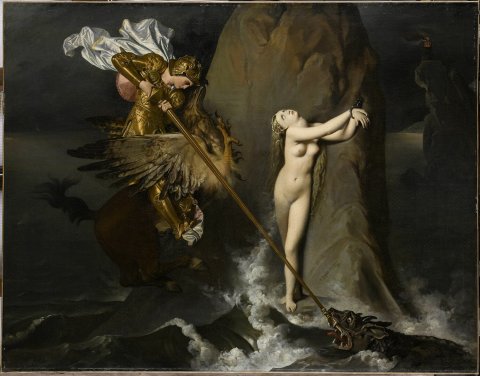Angélique and Olympe abandoned on a rock : from heroic chivalry to perverse exhibition (songs X and XI)
We've seen how the illustration of Canto VII underwent a profound mutation from the Renaissance to the eighteenth century: in the sixteenth century, it's Roger's fight against Eriphile that comes to the fore, as it perpetuates the logic of performance, even if it parodies it. The delights of Alcine's palace, the embrace of Roger and the fairy, do not give rise to a performance. At most, the interior of the palace gives us the image of an anonymous, conventional banquet. It wasn't until the eighteenth century that the paradoxical pairing of Roger, the effeminate knight, and Alcine, the domineering seductress, became established.
.
Similarly, the illustration of Song X begins by favoring either Biren's betrayal (editions Valgrisi and Franceschi), or Roger's fight against the orca (edition Valvassori, edition Nucio d'Anvers in Spanish) : it is only gradually from the eighteenth century onwards that the impossible, thwarted couple formed by Roger and Angélique on the hippogriff (engraving after Cochin, sculpture by Barye), then Angelica's body chained to the rock focus the representation : Tiepolo's Angelica looking up in the manner of a Penitent Madeleine prefigures the provocative Angelics of the late nineteenth century, who maintain a perverse relationship with the spectator's eye: Ingres' Angelica, especially in the first version in the Louvre, is no longer opposed to, but identified with, the killer whale that Roger slays. The Angelica by Gustave Doré smiles as she sways against the teeming tide, where the draftsman has fused waves, snake tail and hippogriff feathers. Both prepare the way for the metamorphosis of Ariosto's modest, freedom-loving Angelica into the perverse creature of A. Robbe-Grillet's sado-masochistic fantasies. Robbe-Grillet in Angélique ou l'enchantement this perversion does not betray the original character; for A. Robbe-Grillet, it is the contemporary expression of freedom which, in Ariosto, was represented by endless flight.
Roger's fight against the orca to deliver Angelica refers to two literary and iconographic models, a medieval one, St. George slaying the dragon to deliver the daughter of the king of Silcha, and an antique model, Perseus' fight to rescue Andromeda. The medieval model establishes the performative framework of the episode and identifies Roger's combat with a feat of chivalry, even though /// At the start of Canto XI, Ariosto gives his story a trivial, grotesque conclusion: just look at the engraving in the Valgrisi edition, where Roger becomes entangled in his clothes as Angelica prepares to disappear in front of him. But it is the ancient model that is most present in the Ariostian story, even though no explicit reference is made to Perseus or Andromeda in the text: Atlant's shield is a nod to Minerva's shield, which Perseus endowed with Medusa's head that petrified those who looked at it. As a precaution, this shield was covered by a cover like Atlant's. The hippogriff is reminiscent of Pegasus, the winged horse ridden by Perseus, although Perseus is not usually depicted mounted on Pegasus when he is slaying the orc. (See, however, the Rubens from the Hermitage.)
Ariosto's account defeats the story of Perseus and Andromeda: 'according to the model, we would expect Roland to defeat the orc and get to marry Angelica as a reward. Indeed, this is the idea behind Roland's journey to ébude from Canto IX onwards (see, for example, the engraving in the Valgrisi edition). But Ariosto tells the story twice, and twice he derails it. Roger, when he saves Angelica from the orca, believes himself authorized to violate her, in defiance of the rules of chivalric courtesy, which order him both to respect Angelica and to remain faithful to Bradamante. As for the faithful but unlucky Roland, he triumphs over the killer whale through short-sightedness, believing he can see Angelique naked in the distance on the rock. Once in possession of Olympe, he finds himself quite embarrassed!
See the chant X and the chant XI.
The engraving of Canto X in the Valgrisi edition.
Roland rescues Isabelle imprisoned with old Gabrine in the brigands' cave (Canto XIII).
///Référence de l'article
Stéphane Lojkine, « Angélique au rocher », Le Roland furieux de l’Arioste : littérature, illustration, peinture (XVIe-XIXe siècles), cours donné au département d’histoire de l’art de l'université de Toulouse-Le Mirail, 2003-2006.
Arioste
Archive mise à jour depuis 2003
Arioste
Découvrir l'Arioste
Épisodes célèbres du Roland furieux
L'île d'Alcine
Angélique au rocher
Bradamante et les peintures
La folie de Roland
Angélique et Médor
Editions illustrées et gravures
Principales éditions de l ’Arioste
Les trois territoires de la fiction
L’effet Argo
Gravures performatives
Gravures narratives
Gravures scéniques

